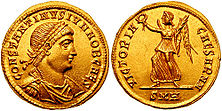
Victoria (mythology)
Encyclopedia

Religion in ancient Rome
Religion in ancient Rome encompassed the religious beliefs and cult practices regarded by the Romans as indigenous and central to their identity as a people, as well as the various and many cults imported from other peoples brought under Roman rule. Romans thus offered cult to innumerable deities...
, Victoria was the personified goddess of victory. She is the Roman equivalent
Interpretatio graeca
Interpretatio graeca is a Latin term for the common tendency of ancient Greek writers to equate foreign divinities to members of their own pantheon. Herodotus, for example, refers to the ancient Egyptian gods Amon, Osiris and Ptah as "Zeus", "Dionysus" and "Hephaestus", respectively.-Roman...
of the Greek goddess
Greek mythology
Greek mythology is the body of myths and legends belonging to the ancient Greeks, concerning their gods and heroes, the nature of the world, and the origins and significance of their own cult and ritual practices. They were a part of religion in ancient Greece...
Nike
Nike (mythology)
In Greek mythology, Nike was a goddess who personified victory, also known as the Winged Goddess of Victory. The Roman equivalent was Victoria. Depending upon the time of various myths, she was described as the daughter of Pallas and Styx and the sister of Kratos , Bia , and Zelus...
, and was associated with Bellona
Bellona (goddess)
Bellona was an Ancient Roman goddess of war, similar to the Ancient Greek Enyo. Bellona's attribute is a sword and she is depicted wearing a helmet and armed with a spear and a torch....
. She was adapted from the Sabine agricultural goddess Vacuna
Vacuna
Vacuna was an ancient Sabine goddess, identified by ancient Roman sources and later scholars with numerous other goddesses, including Ceres, Diana, Nike, Minerva, Bellona, Venus and Victoria. She was mainly worshipped at a sanctuary in near Horace's villa , in sacred woods at Reate, and at...
and had a temple
Temple of Victory
The Temple of Victory is a temple on the Palatine Hill in Rome. It is traditionally ascribed to Evander, but was actually built by Lucius Postumius Megellus out of fines he levied during his aedileship and dedicated by him on 1st August when consul in 294 B.C...
on the Palatine Hill
Palatine Hill
The Palatine Hill is the centermost of the Seven Hills of Rome and is one of the most ancient parts of the city...
. The goddess Vica Pota
Vica Pota
In ancient Roman religion, Vica Pota was a goddess whose shrine was located at the foot of the Velian Hill, on the site of the domus of Publius Valerius Publicola. This location would place the temple on the same side of the Velia as the forum and perhaps not far from the Regia...
was also sometimes identified with Victoria.
Unlike the Greek Nike, Victoria (Latin
Latin
Latin is an Italic language originally spoken in Latium and Ancient Rome. It, along with most European languages, is a descendant of the ancient Proto-Indo-European language. Although it is considered a dead language, a number of scholars and members of the Christian clergy speak it fluently, and...
for "victory") was a major part of Roman society. Multiple temples were erected in her honor. When her statue was removed in 382 CE by emperor Gratianus there was much anger in Rome. She was normally worshipped by triumphant
Roman triumph
The Roman triumph was a civil ceremony and religious rite of ancient Rome, held to publicly celebrate and sanctify the military achievement of an army commander who had won great military successes, or originally and traditionally, one who had successfully completed a foreign war. In Republican...
generals returning from war.
Also unlike the Greek Nike, who was known for success in athletic games such as chariot races, Victoria was a symbol of victory over death and determined who would be successful during war.
Victoria appears widely on Roman coins, jewelry, architecture, and other arts. She is often seen with or in a chariot
Chariot
The chariot is a type of horse carriage used in both peace and war as the chief vehicle of many ancient peoples. Ox carts, proto-chariots, were built by the Proto-Indo-Europeans and also built in Mesopotamia as early as 3000 BC. The original horse chariot was a fast, light, open, two wheeled...
, as in the late 18th-century sculpture representing Victory in a quadriga
Quadriga
A quadriga is a car or chariot drawn by four horses abreast . It was raced in the Ancient Olympic Games and other contests. It is represented in profile as the chariot of gods and heroes on Greek vases and in bas-relief. The quadriga was adopted in ancient Roman chariot racing...
on the Brandenburg Gate
Brandenburg Gate
The Brandenburg Gate is a former city gate and one of the most well-known landmarks of Berlin and Germany. It is located west of the city centre at the junction of Unter den Linden and Ebertstraße, immediately west of the Pariser Platz. It is the only remaining gate of a series through which...
in Berlin
Berlin
Berlin is the capital city of Germany and is one of the 16 states of Germany. With a population of 3.45 million people, Berlin is Germany's largest city. It is the second most populous city proper and the seventh most populous urban area in the European Union...
, Germany.

